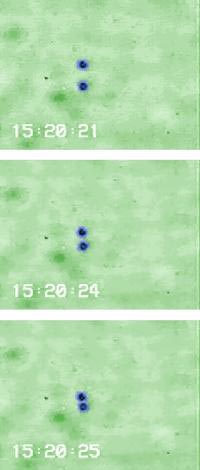'Micro-boxes' of water used to study single molecules

Prodded by optical tweezers, two "hydrosomes" move together and fuse to mix their contents, in an experiment using water droplets as minuscule boxes for manipulating small numbers of biomolecules for nanobiochemistry. Credit: NIST
The unusually simple containment method may enable easier experiments on single molecule dynamics and perhaps lead to the development of molecule-sorting devices that might be used for medical screening or biotechnology research. The work was reported in the July 3 issue of Applied Physics Letters.
The NIST team creates the boxes by briefly shaking a mixture of water, the biomolecules to be studied, and a fluorocarbon medium. Water droplets form in the oily fluorocarbon and naturally encapsulate one to several biomolecules. The researchers then watch through a microscope while using infrared lasers as “optical tweezers” to manipulate and combine the droplets (dubbed “hydrosomes”) inside a tiny chamber on a slide.
A green laser is then used to excite the molecules in individual droplets, and the light emissions over several seconds are analyzed to count the molecules and observe other phenomena. The researchers use two sets of optical tweezers to move droplets together to fuse them and mix their contents (see accompanying video). The team demonstrated the technique by trapping and manipulating droplets encapsulating various molecules (including a delicate protein that survived the shaking process), detecting the fluorescence signal from dye and protein molecules, and observing the transfer of energy from one end of a specially treated DNA molecule to the other.
Water offers several advantages over other methods for containing single molecules, such as attaching them to surfaces or placing them inside liposomes (artificial cells). The water droplets can be held far from any surface that might interfere, can readily encapsulate biomolecules (which prefer being in water as opposed to the fluorocarbon medium), and can readily fuse together to mix molecules or rapidly change their chemical environment. The water droplets currently average about 300 nanometers in diameter and contain volumes measured in quadrillionths of liters; research is continuing to improve methods for controlling droplet size for different applications.
Media Contact
More Information:
http://www.nist.govAll latest news from the category: Physics and Astronomy
This area deals with the fundamental laws and building blocks of nature and how they interact, the properties and the behavior of matter, and research into space and time and their structures.
innovations-report provides in-depth reports and articles on subjects such as astrophysics, laser technologies, nuclear, quantum, particle and solid-state physics, nanotechnologies, planetary research and findings (Mars, Venus) and developments related to the Hubble Telescope.
Newest articles

Combatting disruptive ‘noise’ in quantum communication
In a significant milestone for quantum communication technology, an experiment has demonstrated how networks can be leveraged to combat disruptive ‘noise’ in quantum communications. The international effort led by researchers…

Stretchable quantum dot display
Intrinsically stretchable quantum dot-based light-emitting diodes achieved record-breaking performance. A team of South Korean scientists led by Professor KIM Dae-Hyeong of the Center for Nanoparticle Research within the Institute for…

Internet can achieve quantum speed with light saved as sound
Researchers at the University of Copenhagen’s Niels Bohr Institute have developed a new way to create quantum memory: A small drum can store data sent with light in its sonic…





















